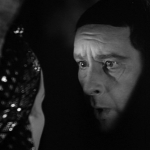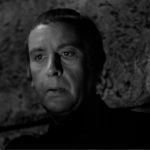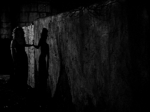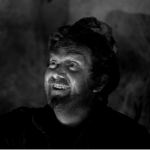So next up is staging, where things, mainly actors, are position in scenes of a movie. As I was looking at the costumes I noticed something, a lot of the shots are medium or close up unless it was a big epic scene or an establishing shot . This makes it hard to get pictures of costumes but it also makes staging difficult to review. Another factor that makes staging reviewing difficult is that the editing cuts between shots are very frequent, though the cuts are not insane or abnormal. Also other than establishing shot you don’t get a feel for the spaces the characters occupy, not even Notre Dame.
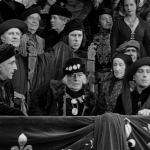
Watching the Play
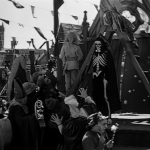
Gringoire's Play
So it’s hard to gauge the characters’ movement in the film space. For the most part I say that the characters use the spaces logically but it’s hard to gauge where the characters are in relation to each other in the space in a given scene. A good example of this is during the Feast of Fools. First you see Louis and Frollo sitting in the royal box watching the festivities. From their vantage point they can see Gringoire’s play. The beggars start to complain that they’re not get money because of the play.

Beggar in long shot
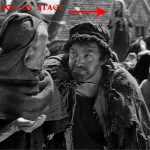
Beggar and Clopin Medium shot
(Edit Alert; in the longer shot as Clopin walk up you can’t see the stage but when the scene cuts to a medium shot of Clopin and the beggar the stage can be seen).
Clopin puts an end to Gringoire’s play and then on the same stage the King of Fools contest begins. As the contest starts we Louis and Frollo talk about it how ugliness is fascinating and how the noble seem interested.
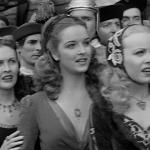
Extras watching the King of Fool contest

Phoebus (left) watches Esmeralda
The scene cuts to nobles looking at the stage, it is in this line up of nobles that Phoebus is seen making a comments about Esmeralda who is dancing.
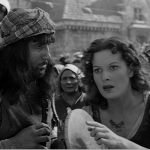
Esmeralda spots an eyes staring
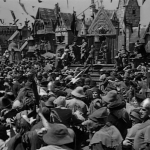
The crowd drags Quasimodo to the stage
As she dances it’s hard to make out where the stage is but it seems to be to left. Louis and Frollo in their box are watching her and looking slightly to the right, as well as Gringoire. Louis and Frollo have to be somewhat close to her as Louis throws her some money without much effort and Quasimodo is hiding under the royal box and Esmeralda can see him staring at her. The crowd then drags Quasimodo to stage which looks like a long distance from the box.
The distance could be attributive to Quasimodo trying to escape the crowd or it’s because the Director William Dieterle was a student of German Expressionism which likes twisting scales and playing distortions. It any case this scene it has some logic but you can’t get a feel for the space. Where is the royal box? How far is it from the stage? Where is Esmeralda performance in relation to the stage and the royal box? These are questions that the film never quite answers because it’s to hard to decern the space, the movement and spacial relation
Next time Sets!

